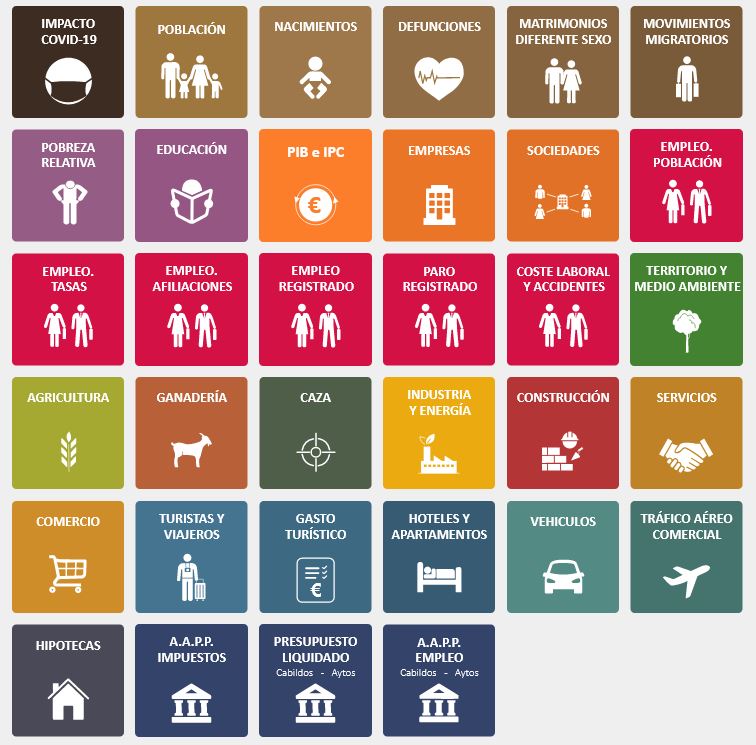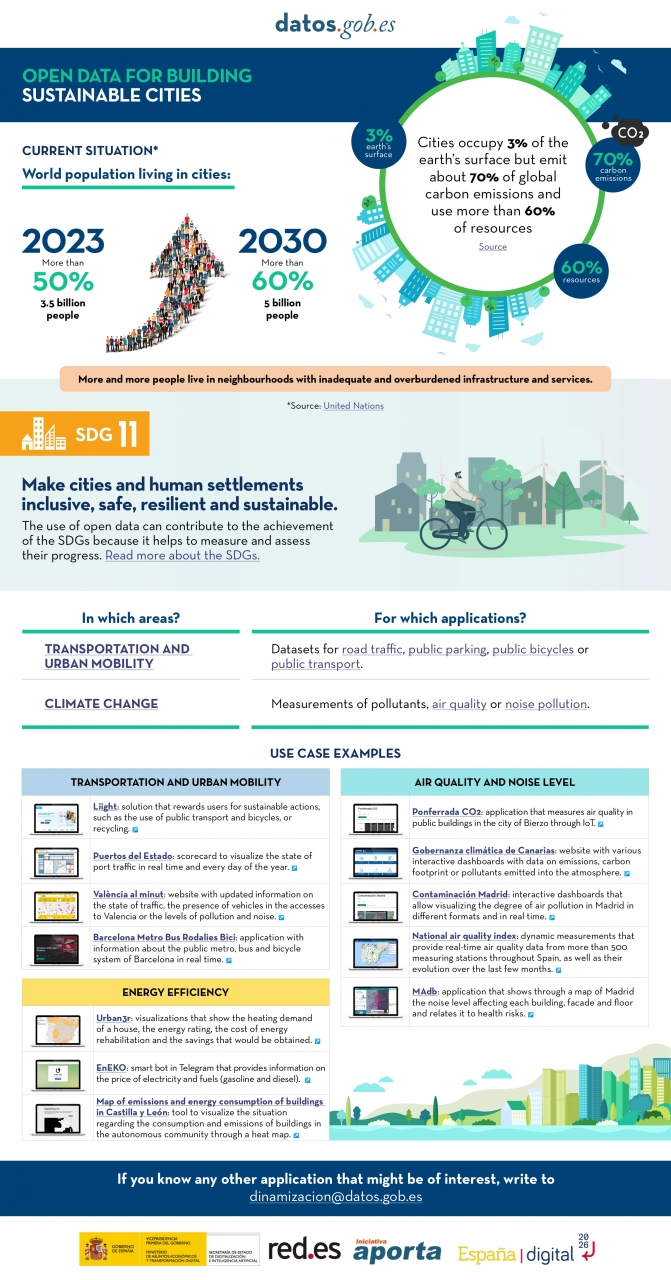Open data is a valuable tool for making informed decisions that encourage the success of a process and enhance its effectiveness. From a sectorial perspective, open data provides relevant information about the legal, educational, or health sectors. All of these, along with many other areas, utilize open sources to measure improvement compliance or develop tools that streamline work for professionals.
The benefits of using open data are extensive, and their variety goes hand in hand with technological innovation: every day, more opportunities arise to employ open data in the development of innovative solutions. An example of this can be seen in urban development aligned with the sustainability values advocated by the United Nations (UN).
Cities cover only 3% of the Earth's surface; however, they emit 70% of carbon emissions and consume over 60% of the world's resources, according to the UN. In 2023, more than half of the global population lives in cities, and this figure is projected to keep growing. By 2030, it is estimated that over 5 billion people would live in cities, meaning more than 60% of the world's population.
Despite this trend, infrastructures and neighborhoods do not meet the appropriate conditions for sustainable development, and the goal is to "Make cities and human settlements inclusive, safe, resilient, and sustainable," as recognized in Sustainable Development Goal (SDG) number 11. Proper planning and management of urban resources are significant factors in creating and maintaining sustainability-based communities. In this context, open data plays a crucial role in measuring compliance with this SDG and thus achieving the goal of sustainable cities.
In conclusion, open data stands as a fundamental tool for the strengthening and progress of sustainable city development.
In this infographic, we have gathered use cases that utilize sets of open data to monitor and/or enhance energy efficiency, transportation and urban mobility, air quality, and noise levels. Issues that contribute to the proper functioning of urban centers.
Click on the infographic to view it in full size.
Local statistical data helps us better understand our environment and identify variations between regions. This is essential to be able to formulate local policies tailored to the specific needs of the local population, something that has even been highlighted by the UN in one of its reports. In this sense, in the datos.gob.es catalog you can find statistical information on different localities and regions, such as the population and housing census, administrative records or even economic indicators.
One of the latest additions to our catalog is the Canary Islands Statistics Institute (Istac), as part of the datos.canarias.es initiative. The institute is the new Canary Islands Open Data Portal that is positioned as the only point of access to open data on the island in collaboration with the rest of the regional public administrations.
At the end of January, datos.canarias.es federated with datos.gob.es, incorporating 7,460 new datasets from the Istac and other organizations on the Island.
What kinds of data sets are available?
The federated data are categorized according to the recommendations of the Application Guide of the Technical Standard for Interoperability for the Reuse of Information Resources and address a wide range of topics related to the territory, the environment, demographics, the economy, and living conditions or the public sector. Shared data is divided into the following categories:

Istac's commitment to open data
The Decree approving the Statistical Plan of the Canary Islands 2018-2022 (PEC-22), establishes that during its execution the reuse of statistical data will be promoted in accordance with the Law on reuse of public sector information. At the same time, it indicates that the Statistical Data and Metadata Infrastructure (eDatos) will be the support for the open and interoperable dissemination of the data published by the statistical activities of the PEC-22, becoming the only channel for the decentralized dissemination of statistics in the corporate websites of the Government of the Canary Islands.
To comply with the aforementioned guidelines, the Istac has made the open data portal of public statistics in the Canary Islands available to the public, which, under the principles of public statistics and data reuse, distributes the data generated in a manner free, in open formats and with licenses that allow its reuse for commercial and non-commercial purposes.
The portal integrates data and metadata based on standardized semantic assets, geographic information and services to promote their use; and it has programmable application interfaces (API) that facilitate the access and download of the information by third parties. In addition to these APIs, it also provides a series of query tools that allow both downloading the data (for example an Extension for QGIS or an R Package), and taking it to another web or application, such as Widgets, Tableau Public or Google Public Data Explorer.
The website also has a statistical indicator viewer. The user can select the information they want to view from a large number of categories, for example, births and deaths, or the workforce. You can also choose the geographic space (the community as a whole or any specific island or municipality), the type of data (annual, interperiodic variation, etc.) and the temporal range. With this information, the tool will generate the graph with the Istac data.
All these tools show the interest of the Istac and the Government of the Canary Islands not only to facilitate access to their data, but also to promote its reuse by developers who want to create value-added products. With its integration in datos.canarias.es, the visibility of the local statistical data of the Canary Islands is promoted, at the same time that access to the data of interest of the entire Autonomous Community is homogenized.
Last December the European Data Portal published a new report entitled Analytical Report 14: Enabling Smart Rural: The Open Data Gap, which examines the collection, availability and use of open data in rural areas.
27% of the citizens of the European Union live in rural areas where it is not easy to implement the same processes, technologies and activities that are driving the cities transformation. In a European context where smart cities are being promoting, the report focuses on the differences and synergies between rural and urban areas in terms of opening and reusing open data. To this end, the available resources have been analysed and 6 respondents have been interviewed: 3 experts from national portals in rural countries (Ireland, Romania and Slovenia) and 3 experts in agriculture, fisheries and the forestry sector.
Availability and reuse of rural data
The first part of the report focuses on knowing the availability of rural data, focusing on two categories of data:
- Rural population data: data relating to people living and working in rural areas, such as the availability of housing, connectivity, access to transport, demographic profile, employment levels or public services access, among others.
- Rural sectors data: Data related to the main sectors of the rural economy, that is, agriculture, fisheries and the forestry sector.
The conclusion reached by the report is that there is more open data from the second category (rural sectors), than from the first (rural population). Specifically, almost 14% (13.75%) of all EDP data sets are agricultural data.
Many of the challenges that public agencies face when opening data in rural areas are the same challenges they face in cities, such as lack of awareness or standardization. However, other aspects such as the digital gap or technological capabilities gaps (worse broadband connection, fewer devices ...) also influence
With regard to reuse, the report highlights the great potential of rural open data to generate economic and social benefits through several examples and success stories, such as increasing transparency in the agricultural products market. As before, the reuse of data related to rural sectors is higher than the reuse of data related to the rural population.
The report also highlights that the majority of rural data reuser and companies are located in urban areas, where awareness of the benefits of this type of data and its possible uses is higher.
Recommendations to boost the opening and reuse of rural data
The report ends with a series of recommendations for member state governments to promote the publication and use of data at the rural level. These recommendations are structured around 3 areas:
- Data collection
- It is necessary to establish and institutionalize open data processes and practices in rural administrations, with close relationships to urban open data groups
- The report recommends paying attention to high-value agricultural datasets, because there is currently a a gap between their agricultural percentage of GDP and their open agricultural datasets.
- Data opening
- Collaboration links must be established with complementary data owners, such as non-profit organizations, researchers or private organizations, that allow data to be opened and made available together.
- The report highlights the term Smart regions, covering both smart cities and nearby rural areas, to generate synergies, and recommends investing in understanding the key factors of smart regions that mean they are more fit for purpose.
- Data reuse
- It is necessary to establish links with urban areas, through instruments such as study centres or universities.
- Finally, the report recommends to identify the rural-specific challenges, such as out-migration, health solutions that address distance, and food provenance.
The report concludes by highlighting the need to institutionalize the commitment to open data and foster the skills necessary for the publication and use of open data on both the population and the rural sectors, so that they are not involuntarily excluded from the benefits of data economy.
